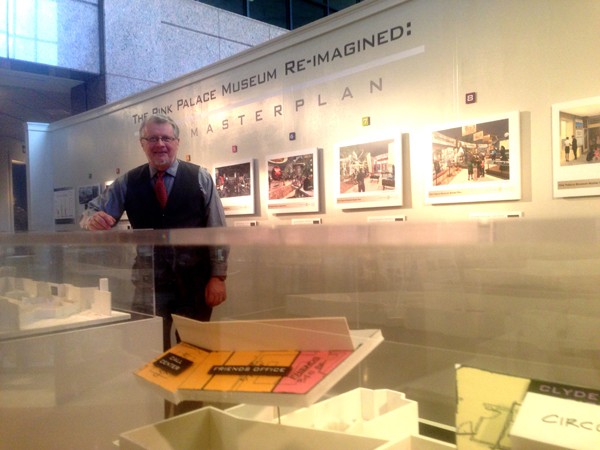The dim room goes completely dark. A pleasant whir begins somewhere above. Then, with a few nimble clicks in the darkness, the stars of the Milky Way appear overhead. The Pink Palace Museum’s Sharpe Planetarium seems to dissolve, lost in the infinity of what looks like a perfect night sky.
Countless curious stargazers and students from across the Mid-South have witnessed this very sight inside the dome of the planetarium. They’ve sat in those laid-back seats in a circle around the skirt of a two-story wonder of the Electronic Age.
The giant mechanical/optical projector — responsible for the whir and clicks — looks like a cross between a satellite and a laser-light rig for a rock show. It has shown the universe to Pink Palace visitors for 32 years.
But its time has come to an end. The planetarium closed for a $1.5 million renovation project last month, and those upgrades include a digital-age projector to replace the old mechanical one.

Steve Pike and the Pink Palace’s master plan exhibit
“It’ll look like a completely different place,” said Steve Pike, director of the Pink Palace Family of Museums. “It’s going to be a much more friendly experience.”
The planetarium will have new seats in a new configuration, and the seat count will rise from 135 to 165. The six-foot wall surrounding the seats will go away, giving a more open feel to the space for a more immersive experience.
No new shows are being made for the museum’s mechanical projector, Pike said. He joked that in its time, science has lost Pluto and gained it back. The new digital projector will allow the Pink Palace to offer more shows and a wider variety of them.
The planetarium is slated to reopen sometime around mid-March 2015, Pike said. It will open with a show about an astronaut that takes an unexpected turn. Wanting to give no spoilers, Pike just said the “show is a great example of what the new technology can do.”
It may seem that interest in space education has waned since the days of the first moon mission, especially in the era of NASA’s now-retired shuttle program. But space exploration still ignites the imagination in films like Gravity and the upcoming Interstellar. The TV series Cosmos, hosted by astrophysicist Neil DeGrasse Tyson, was a can’t-miss event for many.
Tyson urged other scientists to get people excited about science at a meeting of the American Astronomical Society last month, telling them science and astrophysics “are in the hearts and minds of the public right now.”
Space exploration and planetariums rank as one of the highest “category killers” for museums, Pike said, up there with dinosaurs and Native American studies.
“Planetariums give kids a sense of wonder they can’t get otherwise,” he said. “It’s an aspect of nature that’s hard to get at all by yourself.”
But the planetarium renovation is also expected to bring more bodies through the door. Pike said he expects to sell 70,000 planetarium tickets per year, up from an annual average of 60,000.
The planetarium upgrade is one part of an overall project to reshape and modernize the Pink Palace, which is expected to cost about $20 million. The museum’s master plan calls for opening up new spaces in the mansion, a new entrance from Central, and some new exhibits.
“People think of museums as stodgy or unchanging, and that is not at all the case,” Pike said. “[Museums] are innovating all over the country, and we need to keep pace with what people want.”